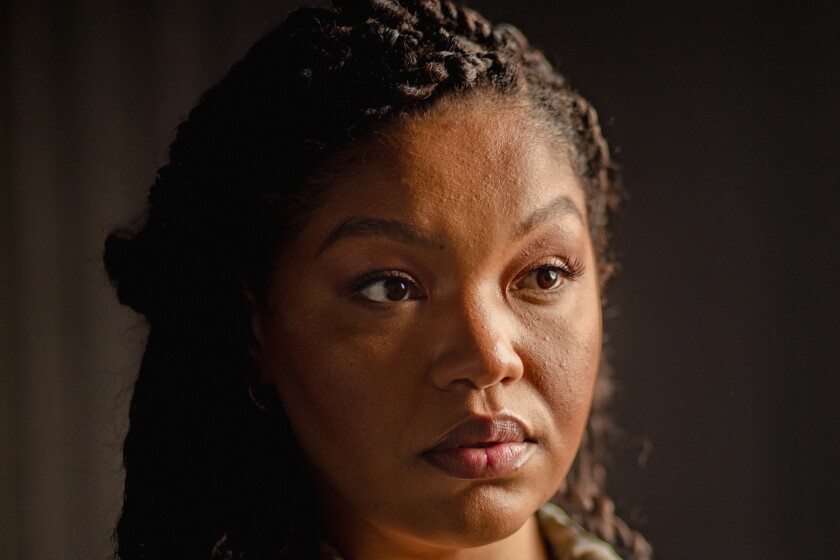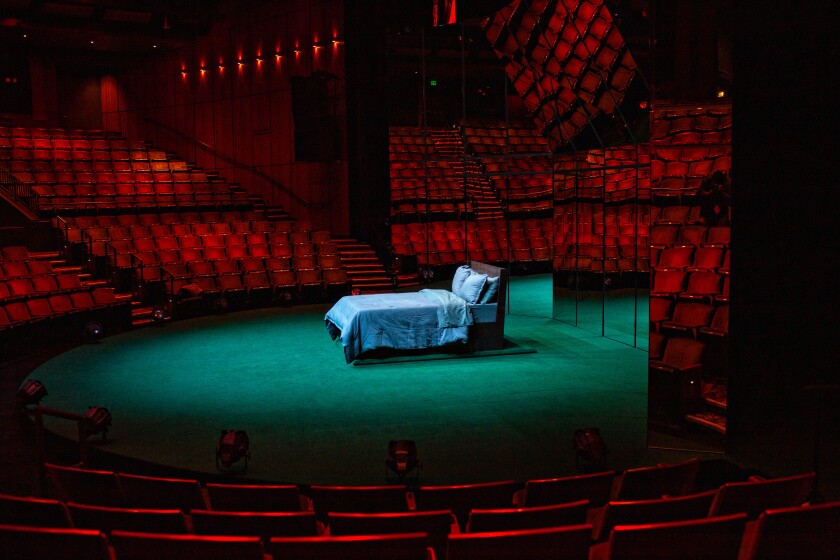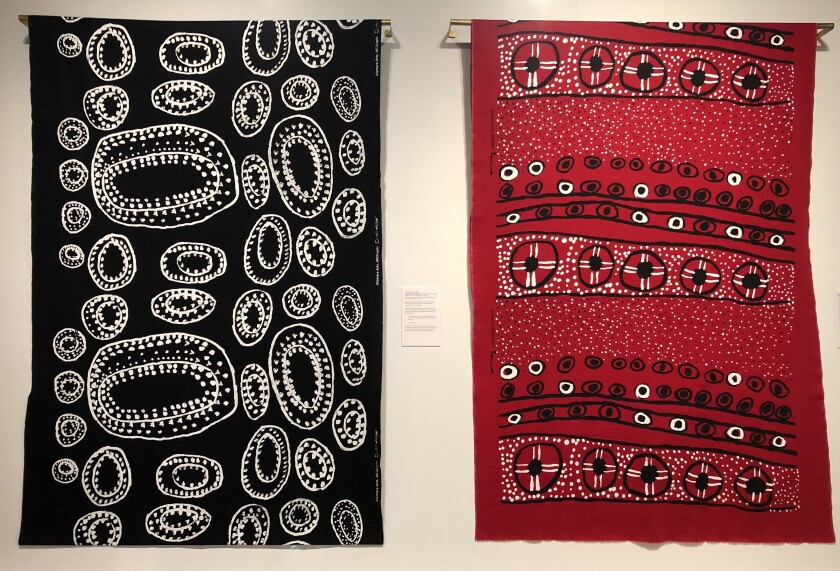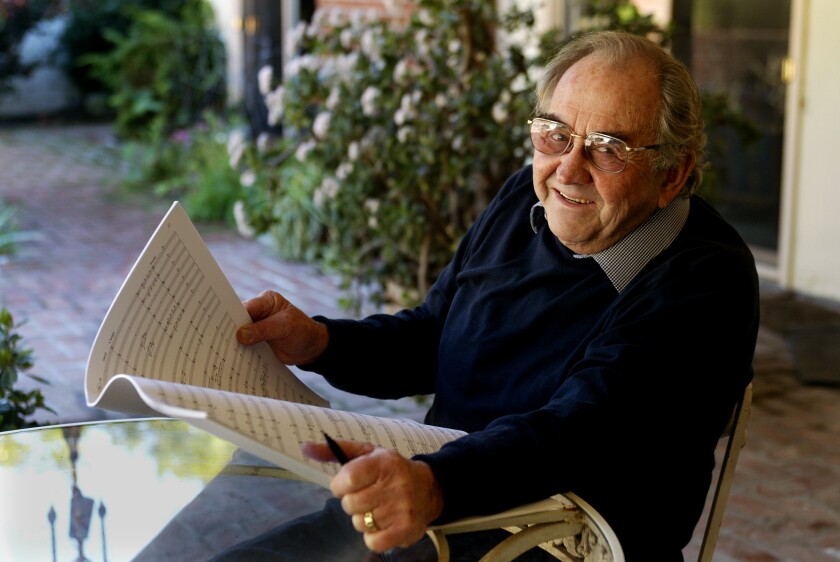Did someone say masa-fried chicken? I’m Carolina A. Miranda, arts and urban design columnist at the Los Angeles Times, and the art world is leaving me hungry. Don’t worry. I’m filling the void with the week’s essential culture news:
Art bazaar
The pandemic may not be over, but the art fairs and their look-at-me merchandise are baaaack!
Frieze landed at the Beverly Hilton this week, with 100 exhibitors representing 17 countries in a fair that is 40% bigger than in previous years. This marks a move from years past, in which the fair was held at the far more inviting Paramount backlot. Even so, the severe eyewear, impossibly high heels and occasional Hollywood celeb were nonetheless on full display.
The crowds descended on Frieze Los Angeles at the Beverly Hilton on Thursday.
(Carolyn Cole / Los Angeles Times)
Times culture reporter Deborah Vankin was on the scene on opening day, where she tallied up the celeb attendance (just OK), and in a place where all anyone does is blab about their sales, she actually witnessed one: for Chris Burden’s resplendent quinceañera gazebo — formally known as “Dreamer’s Folly” — to some high rollers.
Perhaps it might be best if some of Burden’s overstock is better left unseen? Because, oof.

Chris Burden, “Dreamer’s Folly,” 2010, on view at Frieze in Beverly Hills.
(Carolina A. Miranda / Los Angeles Times)
As part of her story, Vankin rounds up all of the New York spaces that are opening locations in L.A., because obviously we’re a town known for our raging art market. This includes upcoming spaces from Sean Kelly, Lisson Gallery, Pace, the Hole and … well, too darn many to list here. (In related news: Thanks to Valentina Di Liscia for letting me have the last word on this phenomenon in a recent story in Hyperallergic.)
Contributor Christina Catherine Martinez gets her party on at Del Vaz Projects — remember parties? — where a new show titled “Shell” features works by the late artists Nicola L. and Heidi Bucher that suggest “dress and undress, and the home as a carapace for such activities.” And indeed, the show takes place in a home, because Del Vaz is inside the home of Jay Ezra Nayssan and Max Goldstein in Santa Monica.
A good symbol for an art fair (and its attendant carbon footprint) might be a mushroom cloud over Los Angeles. Well, artist Nancy Baker Cahill delivers just that, reports Vankin. Just in time for Frieze, Baker Cahill is releasing a new augmented-reality work, “Mushroom Cloud LA | Proximities,” a commission from the digital art platform Aorist. You won’t be able to view her piece at Frieze, however. Because this mushroom cloud is visible only from the Santa Monica Pier.
Enjoying this newsletter? Consider subscribing to the Los Angeles Times
Your support helps us deliver the news that matters most. Become a subscriber.
In the meantime, I have a comprehensive guide to everything there is to eat at the fair. Hint: It’s all very conceptual.
And Times photographer Carolyn Cole comes through with one of our favorite Frieze features: her stunning portfolio of the fair’s most intriguing characters and finest lewks. Yes to neon pink blazers always!
On the stage
If Frieze is inhaling the art world’s attention, the world of Los Angeles theater has been absorbed by the arrival of Jeremy O. Harris’ “Slave Play” to the Mark Taper Forum.
Newsletter
Your essential guide to the arts in L.A.
Get Carolina A. Miranda’s weekly newsletter for what’s happening, plus openings, critics’ picks and more.
Enter email address
Sign Me Up
You may occasionally receive promotional content from the Los Angeles Times.
Here, the playwright has reprised his tradition of staging Black Out performances — in which only Black theater-goers are in attendance. Playwright Inda Craig-Galván writes about the transformative experience of attending one of these shows. “Open engagement is something that Harris welcomed in his opening remarks that night, encouraging audiences to laugh, talk back and to be full participants in the experience of his play,” she writes. “No one was going to silence us. We weren’t an intrusion. We were the event.”
Times theater critic Charles McNulty reviews the Los Angeles production, which was directed by Robert O’Hara. “As a white critic, I’ve appreciated the opportunity to listen not only to Black characters digging into difficult truths but also to the sound of my own silence,” he writes. “It’s not that I haven’t found myself arguing with ‘Slave Play.’ But each time I’ve seen the work, I’ve had a different reaction, which to me is a sign of the work’s complexity.”

“Slave Play” cast member Chalia La Tour at the Mark Taper Forum.
(Jason Armond / Los Angeles Times)
Times photographer Jason Armond has a terrific photographic portfolio of the actors who appear in the show — in which they discuss what this work means to them. “‘Slave Play’ is a time for folks to come together and literally reflect on the power dynamics that remain from the history of slavery in this country,” says Chalia La Tour, who portrays Teá.
The Taper’s thrust stage makes the audience in the show a very visible and very visceral part of the action. Times culture writer Ashley Lee looks at how this new iteration of the play’s set design, which includes strategically placed mirrors, has turned the space into “a wall-to-wall arena in which every attendee, whether seated in the first row or the last, becomes part of the show.” As set designer Clint Ramos says: “We are watching ourselves watch the play. The mirrors force me to deal with the fact that I am actually not exempt from what’s happening onstage.”

“Slave Play” is performed on the Mark Taper Forum’s thrust stage.
(Jason Armond / Los Angeles Times)
Performance notes
Charles McNulty also reports on the best new play he’s seen in ages: Alice Childress’ “Trouble in Mind.” “Yes, I’m aware it was first done in 1955, but the play is only belatedly receiving its due,” he writes. “American theater is at long last ready to listen to a playwright who was calling out systemic racism decades ago in a backstage comedy that is as biting as it is entertaining.”
Actor Bryan Cranston is set to appear in “Power of Sail” at the Geffen Playhouse, in which he plays an aging professor under fire for inviting a white nationalist to participate in a symposium. His appearance represents a shift in the theater’s original plans. Cranston had originally been asked by the Geffen to direct a season in 2019, but the actor handed the directing reins back in the wake of the 2020 uprisings after reflecting on the issues he had been blind to as a performer. “I realized, ‘Oh my God, if there’s one, there’s two, and if there’s two, there are 20 blind spots that I have,” he tells The Times’ Jessica Gelt. “What else am I blind to?”

Bryan Cranston is returning to the stage in “Power of Sail” at the Geffen Playhouse.
(Myung J. Chun / Los Angeles Times)
Visual art report
The Hammer Museum is in the process of expanding its galleries, and that means some new rooms to check out art within the museum, specifically a new 3,100-square-foot exhibition space dedicated to fragile works on paper. Times art critic Christopher Knight paid a visit: “Call it a coming out party for works on paper,” he writes, “as an exceptional collection sees a new light of day.” This includes the Hammer’s own collection and that of the affiliated Grunwald Center for the Graphic Arts. Once finished, the space will be unique: The general public will be able to make appointment-based requests to see some of its treasures.

Alison Saar woodcut/monoprint, “Topsy,” in the collection of the Hammer Museum.
(UCLA Grunwald Center for the Graphic Arts, Hammer Museum)
Classical notes
Esa-Pekka Salonen returned to the conductor’s podium at Disney Hall after an absence of two years — with a program that paid tribute to the hall itself. Salonen, of course, was the musical director of the L.A. Phil who helped champion the construction of the Frank Gehry-designed hall and saw to its completion in 2003. Opening his program last week was the piece that was used to first test the hall’s acoustics: the opening prelude to Bach’s Partita No. 3 for solo violin. The event, writes Times classical music critic Mark Swed, “felt like almost as much of a homecoming as Gustavo Dudamel’s first concert back in the hall in the fall.”

In addition to Bach, Esa-Pekka Salonen conducted his 10-minute chamber piece, “Fog,” written to mark Frank Gehry’s 90th birthday.
(Francine Orr / Los Angeles Times)
Plus, the Hollywood Bowl has announced the star-studded lineup for its 100th anniversary celebration — a 10-day extravaganza that was deferred due to the pandemic. On the roster, reports The Times’ Jessica Gelt, are Billie Eilish, Debbie Harry, Itzhak Perlman, Flying Lotus, Grace Jones, Yuval Sharon of the Industry and composer John Williams (who recently celebrated his 90th birthday). And those are just a few of the marquee names on the list.
Super bits
Mark Swed checked out the various youth orchestras that performed as part Super Bowl LVI and its related events, including the L.A. Phil’s Youth Orchestra Los Angeles and the Inner City Youth Orchestra. As Swed notes, these gestures toward community hardly make up for some of the NFL’s more fraught issues. “The environmental impact of mining cryptocurrency along with the mainstreaming of crypto — dubbed the new subprime by some economists — and marketing it to underserved communities, is staggeringly irresponsible,” writes Swed. “Clearly, the NFL is in need of all the karmacurrency it can get.”
In the meantime, Deborah Vankin spent the Super Bowl whooping it up at the John Lautner-designed Sheats-Goldstein Residence in the Hollywood Hills. There, she took in the sight of a resplendent Italian buffet, wall-to-wall Instagram influencers, Jimmy Goldstein’s sequined jacket and actor Ryan Phillippe holding court by the pool.

Jimmy Goldstein talks with Chloe Poyourow, Kailyn White and Caitlin Hermann at Goldstein’s Super Bowl party.
(Michael Owen Baker / For The Times)
Surprise! The Los Angeles Rams won the Super Bowl, which entailed a parade — a rather short one from the Shrine Auditorium to the Los Angeles Memorial Coliseum. I write about L.A. and it’s rather spotty history of victory parades and how they engage (and don’t) the landscape of the city.
But my favorite Super Bowl-related story of the week is the Rams’ takeover of the Hollywood sign, an epic graphic design fail.
Essential happenings
Presidents Day weekend is upon us, and Matt Cooper has a list of the nine best culture happenings in town. That includes a performance of works by Beethoven and Rachmaninoff by pianist Alessio Bax and the Pacific Symphony at the Segerstrom in O.C. as well as a staging of Stephen Sondheim’s darkly comic musical “Assassins” by the East West Players.
In addition, Lisa Boone has an essential guide to 13 events at Modernism Week in Palm Springs (and beyond), which kicked off Thursday. This includes a show of vintage trailers, as well as tours of a residential fourplex from the 1940s by John Lautner and a revamped William Krisel home. If you can’t get away, there are happenings going down in L.A. — including tours of the home Richard Neutra designed for himself in Silver Lake.
If you find that you need a break from humanity, I highly recommend heading over to UCLA’s Fowler Museum and marinating in an absolutely exquisite textile show. “Aboriginal Screen-Printed Textiles From Australia’s Top End” gathers more than 70 screen-printed textiles made by Aboriginal-owned art centers. This method of creating fabrics, in use since the ’60s, is an absolute riot of color and pattern. A couple are more political in nature, nodding to issues such as Aboriginal self-determination.
The show is on view through July 10.

An installation view of Aboriginal textiles on view at the Fowler Museum.
(Carolina A. Miranda / Los Angeles Times)
While you’re there, don’t miss “‘How Do You See This World?’: The Art of Almighty God,” a show of pieces by the Ghanaian artist Kwame Akoto, whose wry work was born out of sign-painting traditions but now embraces a wide gamut of cultural themes. That show is on view through May 15.
Passages
Percussionist and composer William Kraft, who played a key role in making Los Angeles an important contemporary center of classical music, is dead at 98. As founding conductor of the L.A. Phil’s New Music Group, reports Mark Swed, he “helped transform the notion of what a modern orchestra could become.”

William Kraft’s timpani were an “unmissable component” of the L.A. Phil’s “L.A. sound” during the 1960s and ’70s, writes Mark Swed.
(Carlos Chavez / Los Angeles Times)
Carmen Herrera, a Cuban-born painter known for stark geometric canvases, and who achieved art world success late in life, has died at the age of 106.
In other news
— Actors Gael García Bernal and Diego Luna are co-producing a documentary about the L.A. art collective Asco.
— The Hammer has named the curatorial team for its next “Made in L.A.” biennial: Diana Nawi and Pablo José Ramírez.
— This year’s Met Gala in New York will feature “cinematic vignettes” by a group of filmmakers, including Martin Scorsese, Regina King, Chloé Zhao and Julie Dash, among several others.
— Mexico has passed a law banning the plagiarism or appropriation of art by Indigenous and Afro-Mexican communities, and it sounds like it’s an unenforceable mess.
— A great piece in the Atlantic about how toxic superusers shape Facebook for everyone else.
— Disney has announced plans for an ecologically nightmarish residential development in Rancho Mirage. Comedian Kylie Brakeman predicts their first ad.
— It’s hard to say whose is more terrible: the city of L.A.’s flag or the city of San Francisco’s flag. (Seriously, SF, what’s with the chicken?)
And last but not least …
How hard would it be to hit Jeff Bezos’ superyacht with an egg? Clio Chang at Curbed investigates.


Comments are closed.